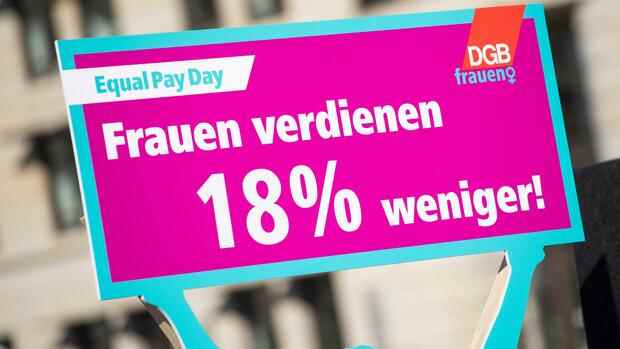The difference in earnings between women and men has not changed compared to the previous year.
(Photo: dpa)
Dusseldorf New year, familiar figures: the wage gap between men and women in Germany is still 18 percent. If you subtract the fact that women work part-time and in poorly paid jobs more often than men, there is still a wage difference of around five to six percent that is not so easy to explain. The difference in earnings between women and men thus remains at the previous year’s level.
For years, the so-called Equal Pay Day, which falls on March 7th in 2022, has only moved slightly forward in the calendar at most. The day symbolically marks the period of the year up to which women work for free, while men are paid for their work from January 1st.
But that could soon change. The reason is a planned EU directive. For the equal pay day, it would mean that it would move forward much more quickly – and would therefore become less and less important. For companies that pay unequally, the pay gap becomes a growing risk.
This is what the European Union’s Fair Pay Directive provides for
The directive aims to narrow the so-called adjusted pay gap, i.e. the wage difference that cannot be explained solely by part-time work or a poorly paid job. As early as 2021, the Commission announced that companies with 250 or more employees with fair pay would have to pay significantly more.
Top jobs of the day
Find the best jobs now and
be notified by email.
According to this, companies should in future disclose information on the adjusted salary gap, among other things, in addition to many other measures. If this is more than five percent, they must explain to the works council why this is the case. Companies across the EU should also indicate salary ranges in job advertisements, which applicants can use as a guide. Sanctions are imminent in the event of violations. Exactly what these look like is still unclear.
The European Council has already approved the planned directive, and the next step is for the EU Parliament to approve it. After the entry into force, the member states have two years to implement the requirements from Brussels.
Economist Henrike von Platen believes that the EU regulation could be passed this year. “What is decisive is that, by default, it is no longer the employee but the employer who has to prove that there is no salary-related discrimination,” says the managing director of the FPI Fair Pay Innovation Lab.
This is what companies can do to close their wage gap
“Companies need to fundamentally address their structures now,” warns Florian Frank, compensation expert at the consulting firm Willis Towers Watson. Because large corporations in particular with their fixed salary brackets are often sluggish when it comes to changing their remuneration structures. There are two, maybe three years little time to take countermeasures.
Not all industries are the same. A current evaluation by the employer rating platform Kununu shows that women starting their careers in the financial sector earn 21 percent less than their male peers. In consulting firms, the gender pay gap at entry level is 14 percent. The figures are partially adjusted, i.e. statistical outliers were excluded from the calculation in order to achieve greater meaningfulness.
Wage gaps within companies also vary in size depending on the area of activity. For example, Frank names sales positions that often have high bonus shares – and where the gender pay gap is traditionally high.
So what can companies do? Expert Frank sees three levers:
- The analysis: Many companies suppressed the fact that “they had a structural problem – it often starts with the tariff area,” says Florian Frank. Companies must therefore first of all analyze where exactly there are injustices in payment. The first DAX companies such as the insurance group Allianz or the aroma manufacturer Symrise are setting good examples and have their remuneration systems checked. “A salary analysis is the key to a fair salary system,” says fair pay expert von Platen.
- The recruiting: “Wage gaps are always an expression that something went wrong in the other HR processes, for example in the hiring process or talent processes,” says Frank. This begins with job advertisements, which often address men rather than women simply by language alone. This could be countered by computer programs that suggest formulations that appeal to both men and women. The panel that selects applicants should also be as diverse as possible to counteract personal bias.
- The promotion: A so-called glass ceiling can still be observed in many sectors. That means: Above a certain hierarchical level, there are hardly any women left. To counteract this, companies could rethink their promotion mechanisms so that, for example, part-time workers also have a fair chance to advance without having to adjust their working hours.
Companies still seem divided. In an online survey conducted by Yougov on behalf of the Indeed job exchange among around 500 executives last May, around 40 percent stated that they were not or rather not in favor of disclosure of salaries. About as many were for it. The agreement was significantly greater among female executives than among male managers.
More: Wage inequality is rising – women can catch up.
